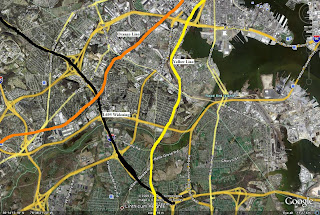
My Own Pictures are Coming Soon
Photo From Developer Website
It was honest Abe some 145 odd years ago who said "A House Divided Will Not Stand." This was during the Civil War years that President Lincoln made this speech but the words still apply today in Baltimore and the entire country. Right now I will apply it to Cherry Hill which may be on the forefront if its own civil war.

Photo From Cherry Hill Master Plan
Cherry Hill differs from other Baltimore in that its history is rather short.The Bulk it was a product of FDRs' "New Deal" to stimulate the economy during the great depression. It was meant to be housing for black World War II veterans returning home. Uplands was its white counterpart. Cherry Hill was built in a time where housing segregation was still the norm. It was one of the last pieces of undeveloped waterfront land in Baltimore located between Westport and Brooklyn it contained some industrial land. After living the life of housing for Veterans the 600 unit Cherry Hill Homes became public housing. Cherry Hill Homes kept expanding over the years topping out at 1713 units. Obviously, Cherry Hill Homes was and is the dominant development creating huge pockets of poverty. 
Photo From Baltimore Housing.org
Cherry Hill didn't enjoy a long period of success as a thriving neighborhood. Crime, drugs, vacancies, population loss, and public health concerns over toke the quality life in Cherry Hill. Cherry Hill Homes began a "modernization" process in the 1990s which included the demolition of 193 units bringing the new total of units to 1520. Some new affordable home ownership town homes were built but for the most part, the land that the public housing units remained vacant. Quality of life in Cherry Hill remained low in Cherry Hill despite the notable success of a few residents, the revitalization of Cherry Hill Town Center, 2 aquatic centers, Cherry Hill Park, Middle Branch Park, Reedbird Park, a youth recreation center, a light rail stop, a branch of an Enoch Pratt Library, and 2 medical centers in addition to Harbor Hospital. Cherry Hill might have the most amenities of any neighborhood in Baltimore. In late 2006 an additional 126 units of Cherry Hill Homes were demolished bringing the grand total down to 1394.

Photo From Cherry Master Plan
Today Cherry Hill is a divided community. There is a market push to develop land as upscale apartments, condos, retail, offices, and possibly a boutique hotel seeing as it is a waterfront community. However, crime, gangs, drugs, still persist at disturbing levels. There have been 12 murders in Cherry Hill in the past year. Still the push is on for market rate housing; Waterview Overlook, a brand new upscale town house/condo development is being built in Cherry Hill and it sold out before they laid the first brick! There is also a waiting list in case people change their mind! 
Photo From Cherry Hill Master Plan
The perfect analogy for the divided Cherry Hill would be the former Arnett J. Brown Jr. Middle School building. It is now home to two high schools New Era Academy and Southside Academy. New Era Academy is the perfect name for the school too because it represents the soon to be influx of new residents a "new era" if you will. New Era Academy also draws citywide and is for college bound students. In sharp contrast Southside Acdemy students are more local and are much more troubled than their fellow New Era tenants. This has erupted in violence between the two schools in at least one instance the schools were put on lock down.

Photo From Developer Website
Now here comes the tricky part; unifying the divided Cherry Hill. Ok lets start with the buildable parcels of land already available. Waterview Overlook is already being built so we can omit that. There is the industrial land next to the light rail station, there is the wooded undeveloped land next to the light rail station, there is the industrial land between Westport and Cherry Hill and finally there is the vacant land left over from the 319 units of Cherry Hill Homes that were demolished in the 1990s and 2006. To deal with the deep concentration of poverty in Cherry Hill I propose using both conventional and unconventional methods. The conventional method would be more demolition in Cherry Hill Homes, 697 units to be exact which is half of the current 1394. Now I'm projecting about 250 of those 697 units are vacant so the number of displaced families isn't as alarming as one would originally think. The demolished units would be redeveloped as mixed use mixed income housing, retail, and offices.
Photo From Cherry Hill Master Plan
Now the unconventional method; the units preserved in Cherry Hill Homes will be the original 600 (or however many of them are still standing) built before World War II. There has been an interest in reusing pre war public housing as market rate housing, something Baltimore hasn't done so I'm proposing that this be done with the oldest Cherry Hill Homes units however many of them are still standing. They were modernized in semi recent years so they would in fact be "de modernized" to restore them to their original appearance to qualify for historic designation. Now where would the remaining 697 families from the old Cherry Hill Homes Go? The only remaining units will be sold as market rate condos! Well they will be in scattered sites throughout Cherry Hill which will now be solely new homes, offices, and businesses.
Photo From Cherry Hill Master Plan
When President Lincoln said "A House Divided Will Not Stand" could he have been thinking of Cherry Hill?







































